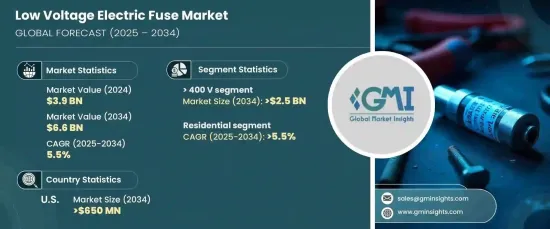
|
市場調査レポート
商品コード
1667007
低電圧電気ヒューズ市場の機会、成長促進要因、産業動向分析、2025年~2034年の予測Low Voltage Electric Fuse Market Opportunity, Growth Drivers, Industry Trend Analysis, and Forecast 2025 - 2034 |
||||||
カスタマイズ可能
|
|||||||
| 低電圧電気ヒューズ市場の機会、成長促進要因、産業動向分析、2025年~2034年の予測 |
|
出版日: 2024年12月03日
発行: Global Market Insights Inc.
ページ情報: 英文 110 Pages
納期: 2~3営業日
|
- 全表示
- 概要
- 目次
低電圧電気ヒューズの世界市場は、2024年に39億米ドルと評価され、2025年から2034年のCAGRは5.5%と予測され、着実な成長が見込まれています。
この成長の原動力となっているのは、さまざまな分野における電気安全ソリューションに対する需要の高まりと、特に新興市場における建設活動の急増です。電気システムがより複雑化し、特に電子機器使用の増加により負荷が増大するにつれて、電気障害に対する信頼性の高い保護の必要性がより重要になっています。さらに、再生可能エネルギーシステムへの世界のシフトは、家庭、企業、産業施設の電気インフラを保護することの重要性を強調しています。

400Vで動作する電気システムの市場セグメントは、2034年までに25億米ドルを生み出すと予測されています。電気自動車の普及が進んでいることに加え、急速な都市化や発展途上地域でのインフラ開発が進んでいることが、低電圧ヒューズを含む高度な電気部品の需要を促進しています。世界各国の政府は厳しい安全規制を実施しており、住宅、商業、工業プロジェクトにおけるこれらのヒューズの展開をさらに促進しています。
| 市場範囲 | |
|---|---|
| 開始年 | 2024 |
| 予測年 | 2025-2034 |
| 開始金額 | 39億米ドル |
| 予測金額 | 66億米ドル |
| CAGR | 5.5% |
住宅セクターは、2034年までのCAGRが5.5%と、力強いペースで成長すると予測されます。新興国では都市化が加速しており、電気の安全性と電力システムの信頼性への関心が高まっています。住宅建設の増加や、エアコン、冷蔵庫、テレビなどの電化製品需要の増加は、住宅用ヒューズの需要を促進する主な要因です。さらに、住宅用電気システムの安全性向上を目的とした政府規制も市場拡大に寄与しています。
米国の低電圧電気ヒューズ市場は、2034年までに6億5,000万米ドルを創出すると予想されています。家電製品の普及や住宅・商業ビルの建設と相まって、電気安全への関心が高まっていることが市場の成長を促進しています。電気保護に投資する家庭や企業が増える中、IoTに接続されたスマートデバイスの人気が高まっており、信頼性の高いヒューズの需要がさらに高まっています。
全体的には、配電網の改善への取り組み、自動車セクターの拡大(特に電気自動車の台頭)、送電網インフラの近代化に対する継続的な取り組みに支えられ、市場は継続的な成長を遂げる構えです。これらの要因は、低電圧電気ヒューズ市場にとって有利な環境を作り出し、複数の業界にわたる旺盛な需要を確保すると予想されます。
目次
第1章 調査手法と調査範囲
- 市場の定義
- 基本推定と計算
- 予測計算
- データソース
- 1次データ
- 2次データ
- 有償
- 公的
第2章 エグゼクティブサマリー
第3章 業界洞察
- エコシステム分析
- 規制状況
- 業界への影響要因
- 促進要因
- 業界の潜在的リスク&課題
- 成長可能性分析
- ポーターの分析
- 供給企業の交渉力
- 買い手の交渉力
- 新規参入業者の脅威
- 代替品の脅威
- PESTEL分析
第4章 競合情勢
- イントロダクション
- 戦略ダッシュボード
- イノベーションと持続可能性の展望
第5章 市場規模・予測:電圧別、2021年~2034年
- 主要動向
- 低電圧
- 100V以下
- 100V-250V
- 250V-400V
- 400V以上
第6章 市場規模・予測:定格電流別、2021年~2034年
- 主要動向
- 500A以下
- 500A-2000A
- 2000-4000A
- 4000A以上
第7章 市場規模・予測:用途別、2021年~2034年
- 主要動向
- 住宅用
- 商業用
- 産業用
- ユーティリティ
第8章 市場規模・予測:最終用途別、2021年~2034年
- 主要動向
- 電力変圧器
- 家庭用電気配線
- 電化製品
- 電子機器
- 自動車
- その他
第9章 市場規模・予測:地域別、2021年~2034年
- 主要動向
- 北米
- 米国
- カナダ
- メキシコ
- 欧州
- 英国
- ノルウェー
- ドイツ
- イタリア
- オランダ
- アジア太平洋
- 中国
- 日本
- インド
- 韓国
- タイ
- 中東・アフリカ
- サウジアラビア
- UAE
- クウェート
- トルコ
- オマーン
- ラテンアメリカ
- ブラジル
- アルゼンチン
第10章 企業プロファイル
- Bel Fuse
- C&S Electric
- Eaton
- Fuji Electric
- Hubbell
- Kyocera
- Legrand
- Mersen
- Mitsubishi Electric
- Optifuse
- Panasonic
- S&C Electric
- Schneider Electric
- SIBA
- Siemens
The Global Low Voltage Electric Fuse Market, valued at USD 3.9 billion in 2024, is expected to experience steady growth, with a projected CAGR of 5.5% during 2025-2034. This growth is driven by increasing demand for electrical safety solutions across various sectors, as well as a surge in construction activities, particularly in emerging markets. As electrical systems become more complex and loads increase, particularly due to the rise in electronic device usage, the need for reliable protection against electrical faults has become more critical. Furthermore, the global shift toward renewable energy systems underscores the importance of safeguarding electrical infrastructure in homes, businesses, and industrial facilities.

The market segment for electrical systems operating at 400 V is forecast to generate USD 2.5 billion by 2034. The increasing adoption of electric vehicles, coupled with rapid urbanization and ongoing infrastructure development in developing regions, is driving the demand for advanced electrical components, including low voltage fuses. Governments worldwide are implementing stringent safety regulations, further encouraging the deployment of these fuses in residential, commercial, and industrial projects.
| Market Scope | |
|---|---|
| Start Year | 2024 |
| Forecast Year | 2025-2034 |
| Start Value | $3.9 billion |
| Forecast Value | $6.6 Billion |
| CAGR | 5.5% |
The residential sector is projected to grow at a robust pace, with a CAGR of 5.5% through 2034. As urbanization accelerates in emerging economies, there is a heightened focus on electrical safety and the reliability of power systems. The growing construction of homes and the rising demand for electrical appliances like air conditioners, refrigerators, and televisions are key factors driving the demand for residential fuses. Additionally, government regulations aimed at enhancing safety in residential electrical systems are contributing to the market's expansion.
U.S. low voltage electric fuse market is expected to generate USD 650 million by 2034. The increasing focus on electrical safety, coupled with the widespread use of consumer electronics and the construction of both residential and commercial buildings, is fostering market growth. As more households and businesses invest in electrical protection, the rising popularity of IoT-connected smart devices is further propelling the demand for reliable fuses.
Overall, the market is poised for continued growth, supported by efforts to improve distribution networks, the expanding automotive sector-especially with the rise of electric vehicles-and ongoing initiatives to modernize grid infrastructure. These factors are expected to create a favorable environment for the low voltage electric fuse market, ensuring robust demand across multiple industries.
Table of Contents
Chapter 1 Methodology & Scope
- 1.1 Market definitions
- 1.2 Base estimates & calculations
- 1.3 Forecast calculation
- 1.4 Data sources
- 1.4.1 Primary
- 1.4.2 Secondary
- 1.4.2.1 Paid
- 1.4.2.2 Public
Chapter 2 Executive Summary
- 2.1 Industry synopsis, 2021 - 2034
Chapter 3 Industry Insights
- 3.1 Industry ecosystem analysis
- 3.2 Regulatory landscape
- 3.3 Industry impact forces
- 3.3.1 Growth drivers
- 3.3.2 Industry pitfalls & challenges
- 3.4 Growth potential analysis
- 3.5 Porter's analysis
- 3.5.1 Bargaining power of suppliers
- 3.5.2 Bargaining power of buyers
- 3.5.3 Threat of new entrants
- 3.5.4 Threat of substitutes
- 3.6 PESTEL analysis
Chapter 4 Competitive Landscape, 2024
- 4.1 Introduction
- 4.2 Strategic dashboard
- 4.3 Innovation & sustainability landscape
Chapter 5 Market Size and Forecast, By Voltage, 2021 – 2034 (USD Million, ‘000 Units)
- 5.1 Key trends
- 5.2 Low
- 5.3 <100V
- 5.4 100V-250V
- 5.5 250V-400V
- 5.6 > 400V
Chapter 6 Market Size and Forecast, By Current Rating, 2021 – 2034 (USD Million, ‘000 Units)
- 6.1 Key trends
- 6.2 < 500A
- 6.3 500A-2000A
- 6.4 2000-4000A
- 6.5 > 4000A
Chapter 7 Market Size and Forecast, By Application, 2021 – 2034 (USD Million, ‘000 Units)
- 7.1 Key trends
- 7.2 Residential
- 7.3 Commercial
- 7.4 Industrial
- 7.5 Utility
Chapter 8 Market Size and Forecast, By End Use, 2021 – 2034 (USD Million, ‘000 Units)
- 8.1 Key trends
- 8.2 Power transformers
- 8.3 Home electrical cabling
- 8.4 Electrical appliances
- 8.5 Electronic devices
- 8.6 Automotive
- 8.7 Others
Chapter 9 Market Size and Forecast, By Region, 2021 – 2034 (USD Million, ‘000 Units)
- 9.1 Key trends
- 9.2 North America
- 9.2.1 U.S
- 9.2.2 Canada
- 9.2.3 Mexico
- 9.3 Europe
- 9.3.1 UK
- 9.3.2 Norway
- 9.3.3 Germany
- 9.3.4 Italy
- 9.3.5 Netherlands
- 9.4 Asia Pacific
- 9.4.1 China
- 9.4.2 Japan
- 9.4.3 India
- 9.4.4 South Korea
- 9.4.5 Thailand
- 9.5 Middle East & Africa
- 9.5.1 Saudi Arabia
- 9.5.2 UAE
- 9.5.3 Kuwait
- 9.5.4 Turkey
- 9.5.5 Oman
- 9.6 Latin America
- 9.6.1 Brazil
- 9.6.2 Argentina
Chapter 10 Company Profiles
- 10.1 Bel Fuse
- 10.2 C&S Electric
- 10.3 Eaton
- 10.4 Fuji Electric
- 10.5 Hubbell
- 10.6 Kyocera
- 10.7 Legrand
- 10.8 Mersen
- 10.9 Mitsubishi Electric
- 10.10 Optifuse
- 10.11 Panasonic
- 10.12 S&C Electric
- 10.13 Schneider Electric
- 10.14 SIBA
- 10.15 Siemens


